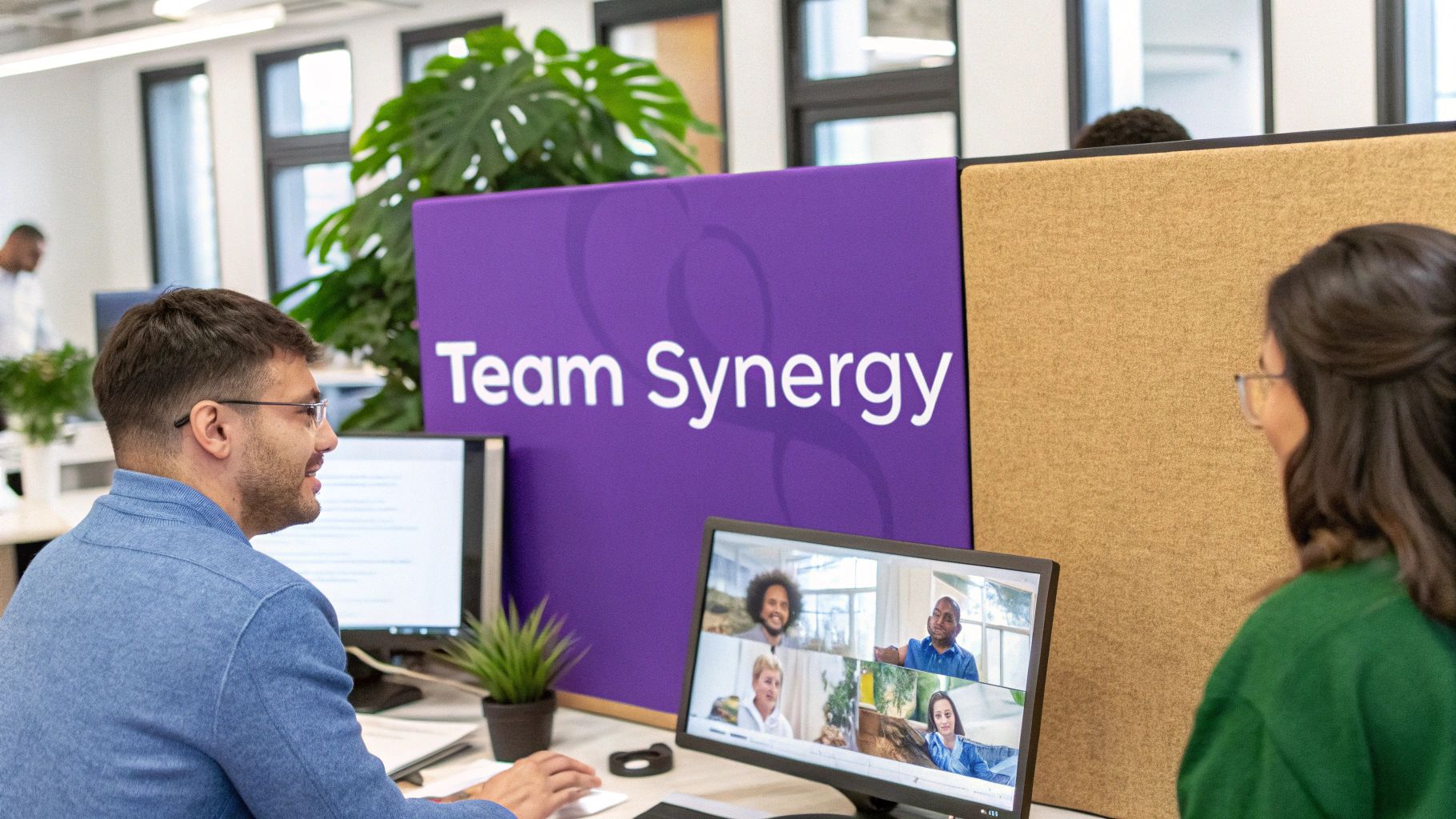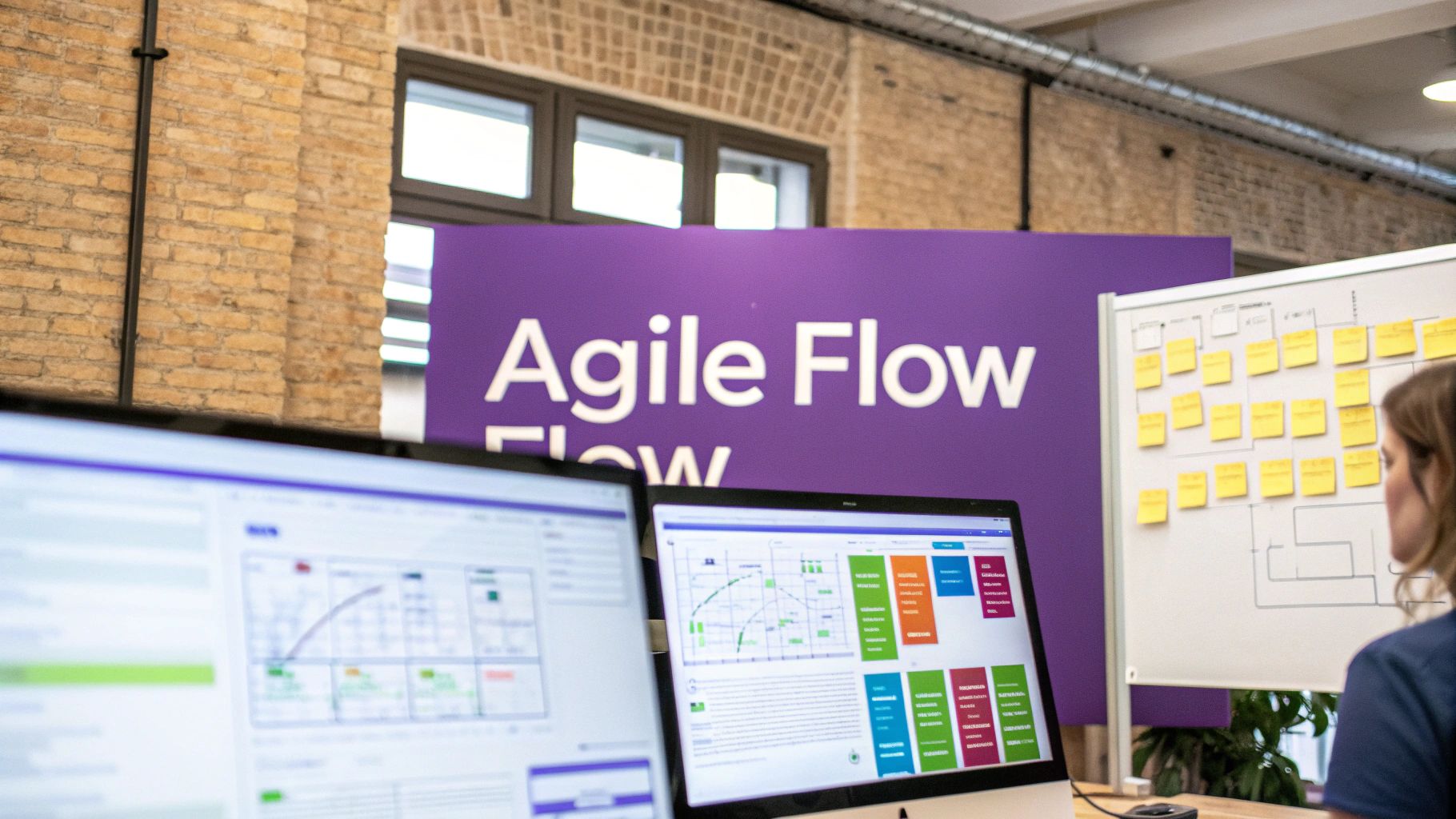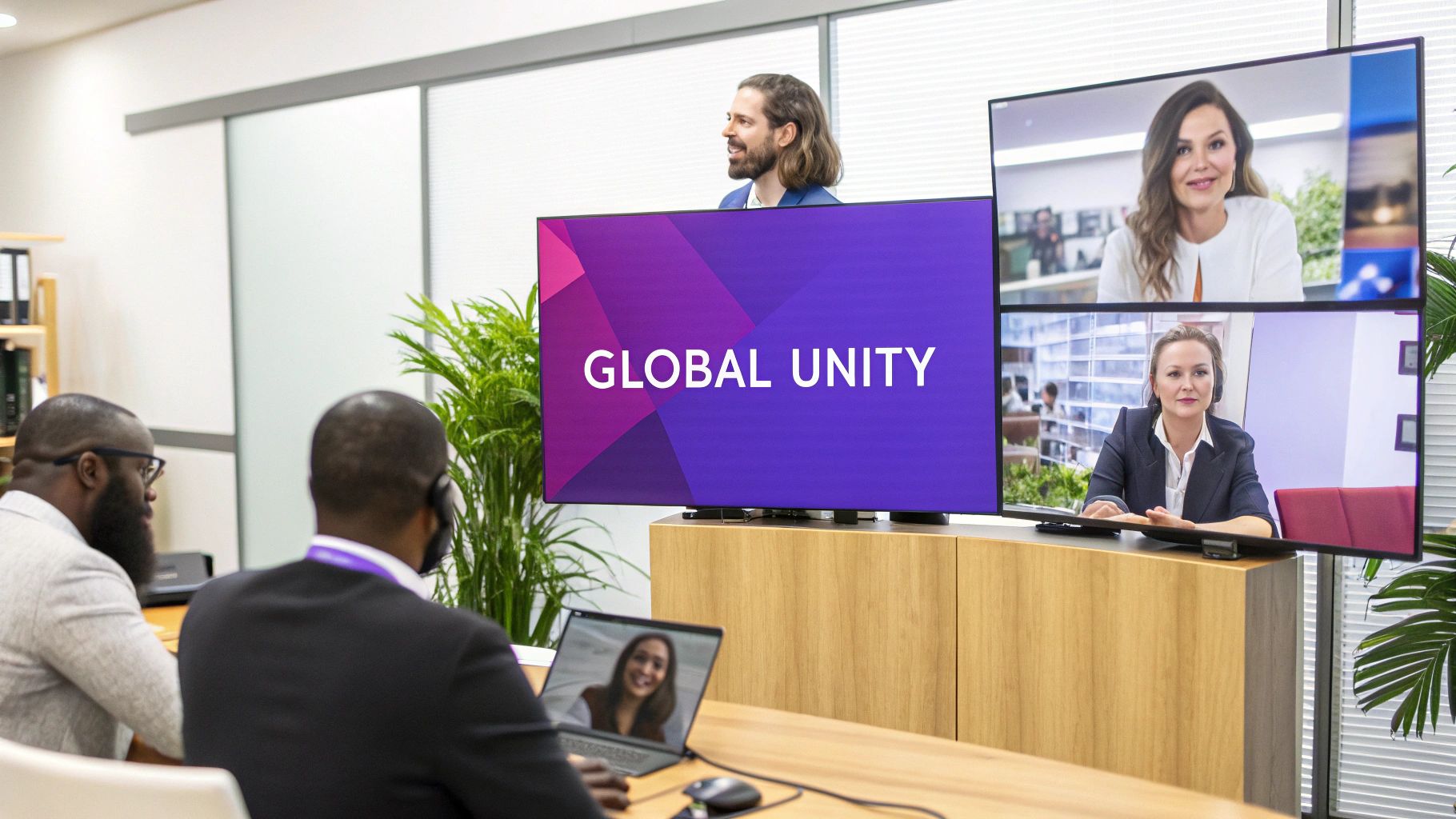The Evolution of Distributed Agile Teams

Not long ago, the concept of a fully distributed agile team was unusual. Teams mostly worked together in a shared office space, implementing agile methodologies within those physical limitations. The business world has changed significantly since then.
Today, distributed agile teams are not only common but often the preferred working model for many organizations. This shift represents a fundamental change in how we think about teamwork and project management.
Drivers of Change
Several factors have driven this evolution. Finding specialized talent has become increasingly challenging, forcing companies to look beyond their local area. Distributed agile offers a solution, allowing businesses to access a global talent pool.
The growing desire for workplace flexibility has also played a significant role. Employees value the autonomy and work-life balance that comes with remote work, and distributed agile supports this preference. This means companies can attract and retain top talent by offering flexible work arrangements.
Global market pressures have further accelerated the adoption of distributed agile. Working across time zones allows for continuous workflow and faster delivery, providing a competitive advantage. For example, a software development team with members in different time zones can work around the clock, leading to faster releases.
This has led to widespread adoption of agile practices, especially in distributed teams. In fact, recent data shows over 80% of U.S. federal IT projects are now agile or iterative, a significant increase from previous years. You can find more detailed statistics here: Agile Statistics.
Reimagining Collaboration
Forward-thinking organizations are not merely adapting to distributed agile; they are actively rethinking collaboration. They are using asynchronous communication tools and strategies that empower teams to work effectively across different time zones.
This includes using project management software like Asana, instant messaging platforms like Slack, and virtual meeting spaces like Zoom to facilitate seamless communication and collaboration. However, the change goes beyond just the tools.
From Obstacle to Advantage
Leading organizations are actively building a culture of trust, transparency, and mutual respect within their distributed agile teams. They understand that strong relationships and open communication are essential for success in a virtual environment.
By prioritizing these cultural elements, they turn geographical distance from a potential problem into a strategic advantage. This allows teams to benefit from the diverse perspectives and experiences of their globally distributed members.
This new way of working opens up access to a wider talent pool, fosters innovation, and speeds up project delivery.
Unlocking the Power of Global Talent Distribution

Distributed agile teams represent a major change in how businesses operate. They offer access to a much larger pool of talent than traditional in-house teams. This expansion allows companies to build teams with diverse perspectives and specialized skills not always available locally.
This wider talent pool can fuel innovation and enhance problem-solving by bringing together people with unique viewpoints and experiences. It's a new way of working that offers exciting possibilities.
Accessing Global Talent Pools
One of the biggest advantages of distributed agile teams is recruiting talent from anywhere in the world. This allows companies to tap into specialized skills that might be scarce in their local area. For instance, a company needing expertise in a particular programming language like Python can recruit developers from regions known for those skills, regardless of their location.
As businesses increasingly seek to expand their global talent pool, considering locations like the Philippines can offer significant advantages. You can read more about it here: Offshore Call Center Philippines. This global approach also promotes diversity within teams.
By bringing together individuals from different backgrounds and cultures, companies create a richer understanding of various markets and customer needs. This diversity often leads to more creative and effective solutions that connect with a broader audience.
The Follow-the-Sun Workflow
Another key benefit of distributed agile teams is the potential for a follow-the-sun workflow. With team members located across various time zones, work can continue almost 24/7. This constant progress significantly speeds up project timelines and reduces the time it takes to bring new products or features to market.
This means projects can advance much faster compared to traditional teams working in the same location. The increased efficiency can be a real game-changer for businesses.
Addressing the Challenges
While the benefits are substantial, distributed agile teams also have their challenges. Effective communication is crucial. Time zone differences, language barriers, and cultural nuances can lead to misunderstandings if not addressed proactively. However, over 80% of businesses report using Agile best practices with their distributed teams, demonstrating a strong commitment to tackling these challenges. For more detailed statistics, check out: Distributed Agile Team Challenges.
Maintaining a strong team culture can also be tricky when team members are geographically dispersed. Building trust and rapport takes dedicated effort and often involves virtual team-building activities. These activities foster a sense of belonging and strengthen team cohesion despite the physical distance.
Finally, ensuring everyone has access to the same technologies and tools is essential. Using consistent technology platforms streamlines communication, file sharing, and overall collaboration. This simplifies workflows and allows the team to focus on achieving its objectives. Overcoming these obstacles requires planning and ongoing management, enabling distributed agile teams to reach their full potential.
The Distributed Agile Tech Stack That Actually Works

Building a high-performing distributed agile team takes more than simply adopting agile principles. It requires a carefully selected technology ecosystem. This isn't about choosing just any project management tool. It's about creating a seamless, integrated environment that empowers team members to collaborate effectively, regardless of their location. This means focusing on tools that go beyond basic functionality and truly enable a distributed workflow.
Key Considerations For Tool Selection
High-performing global teams evaluate tools based on several key factors. Asynchronous communication is the cornerstone of distributed agile success. Teams prioritize tools that facilitate clear and efficient communication without requiring everyone to be online at the same time.
Transparency and visibility are also essential. This includes project management platforms that provide a shared understanding of project status, progress, and individual contributions. Tools that facilitate efficient documentation are also crucial, preventing knowledge silos and promoting shared understanding.
Finally, leading organizations focus on building a unified technology stack that integrates seamlessly. This reduces context switching and streamlines workflows. It allows team members to focus on delivering value, rather than struggling with multiple, disconnected tools.
Essential Tools For Distributed Agile Teams
Specific tool choices will depend on individual team needs. However, several categories are crucial for distributed agile success.
-
Project Management: Tools like Jira, Asana, or Trello provide centralized task management, progress tracking, and collaboration features. These platforms create a single source of truth for the project, ensuring everyone stays aligned.
-
Communication & Collaboration: Platforms like Slack, Microsoft Teams, or Google Workspace facilitate real-time and asynchronous communication, file sharing, and virtual meetings. These tools become the digital equivalent of a water cooler, fostering both project-related and social interaction.
-
Virtual Whiteboarding & Visual Collaboration: Tools like Miro or Mural allow distributed teams to brainstorm, visualize ideas, and collaborate on diagrams and workflows remotely. They recreate the energy of in-person whiteboarding sessions.
-
Code Collaboration & Version Control: Platforms like GitHub or GitLab enable distributed development teams to collaborate on code efficiently, manage versions, and track changes. These are vital for maintaining code integrity and facilitating seamless integration. For a deeper dive, check out this guide on Collaboration Tools for Remote Teams.
To illustrate the diverse landscape of tools available, consider the following comparison:
To help you navigate the available options, here's a comparison of common tools:
Distributed Agile Collaboration Tool Comparison
This table compares popular tools used by distributed agile teams across different categories, highlighting key features, pricing, and suitability for different team sizes and needs.
| Tool Category | Popular Options | Key Features | Best For | Limitations |
|---|---|---|---|---|
| Project Management | Jira, Asana, Trello | Task management, progress tracking, collaboration | Small to large teams | Can become complex for simple projects |
| Communication & Collaboration | Slack, Microsoft Teams, Google Workspace | Real-time & asynchronous communication, file sharing, virtual meetings | All team sizes | Over-reliance can lead to information overload |
| Virtual Whiteboarding & Visual Collaboration | Miro, Mural | Brainstorming, visualization, remote diagramming | Teams needing visual collaboration | Requires active participation for effectiveness |
| Code Collaboration & Version Control | GitHub, GitLab | Code collaboration, version control, change tracking | Development teams | Steeper learning curve for non-developers |
This table highlights the variety of tools available, each catering to specific needs within a distributed agile team. Choosing the right combination is key to success.
Building A Unified and Effective Ecosystem
The power of a distributed agile tech stack lies not just in the individual tools, but in their integration. This means choosing tools that work together smoothly, sharing information and reducing manual data transfer. For example, integrating project management tools with communication platforms allows updates and notifications to flow seamlessly, keeping everyone informed without constant email checks.
By focusing on integration, distributed teams create a digital workspace that mirrors the collaborative environment of a co-located team. This empowers team members to focus on what matters most: delivering value quickly and efficiently. You might be interested in this resource: Collaboration Tools for Remote Teams. This cohesive tech ecosystem becomes the backbone of a successful distributed agile strategy, fostering collaboration, communication, and ultimately, successful project delivery.
Communication Bridges Across Time and Space

Communication is essential for any team. For distributed agile teams, however, it can be uniquely challenging. Time zones, languages, and cultural differences can create obstacles. This means teams must proactively build communication bridges. Overcoming these challenges transforms communication from a potential weakness into a strength.
Mastering Synchronous and Asynchronous Communication
Effective communication starts with balancing synchronous and asynchronous communication. Synchronous communication, like video conferencing with Zoom, happens in real time. It's great for brainstorming and building rapport. But, constant real-time communication across time zones can cause burnout.
Asynchronous communication lets team members contribute on their own schedules. Examples include email, Slack, and shared documents. This respects work-life balance and offers flexibility. A team member in Tokyo can reply to a London colleague's question overnight, ensuring continuous progress.
Documentation: Building Durable Team Memory
Documentation is vital for asynchronous communication. Detailed project plans, meeting notes, and decisions create a shared history. This "team memory" is accessible to everyone, regardless of location or time zone. New team members can quickly get up to speed, and everyone can easily reference past discussions. Good documentation also prevents knowledge silos.
Building Trust Through Virtual Interactions
Building trust in a distributed team takes effort. Regular virtual social interactions, even short check-ins, help build rapport. Consider virtual coffee breaks or online team-building activities. Even a few minutes of casual conversation before meetings can foster genuine connection despite physical distance.
Practical Communication Strategies for Distributed Agile Teams
Here are some clear strategies for effective communication:
- Establish Core Communication Hours: Overlapping work hours, even for a few hours a day, help with critical discussions.
- Utilize Communication Platforms Strategically: Choose the right tools and integrate them well. This minimizes context switching and keeps everyone informed. For further tips, check out this article on How to master remote collaboration.
- Embrace Transparency: Openly sharing information builds trust and keeps the team aligned.
- Promote Cultural Sensitivity: Encourage team members to learn about each other's cultures and communication styles to avoid misunderstandings.
By using these strategies, distributed agile teams can overcome communication barriers and build strong connections. This improves collaboration and productivity, creating a more engaged team. This allows distributed teams not only to function but to thrive. Interested in learning more? Check out this helpful resource: How to master remote collaboration. This intentional approach turns distance into an opportunity, unlocking the distributed agile model's full potential.
Building a Unified Culture Despite Physical Separation
Building a strong team culture is essential for any team. However, it can be particularly challenging for distributed agile teams. When team members work across various locations and time zones, fostering a sense of belonging and shared purpose takes focused effort. This section explores practical strategies to transform a distributed group into a cohesive, high-performing team.
Fostering Psychological Safety and Connection
Creating psychological safety is crucial. Team members should feel comfortable sharing their ideas, taking risks, and seeking help without fear of judgment. In a distributed team, this involves actively creating opportunities for open communication and feedback. Regular virtual check-ins, both formal and informal, can help build rapport and trust.
Building genuine connections, even with limited face-to-face interaction, is also essential. Encourage virtual social interactions, such as online team-building activities or virtual coffee breaks. These casual interactions help team members connect personally, strengthening team bonds.
Virtual Team-Building and Recognition
Virtual team-building activities can be very effective when executed thoughtfully. Avoid forced or awkward activities. Instead, focus on activities that promote collaboration and shared experiences. Think online games or virtual escape rooms. Recognizing achievements is also crucial for a positive team culture.
Implement recognition practices that work across time zones. Publicly acknowledge contributions during team meetings or establish a dedicated online space to celebrate successes. This demonstrates appreciation and reinforces positive behavior. Learn more in this helpful article: How to master leading remote teams.
Conflict Resolution in Distributed Contexts
Conflict is unavoidable in any team. Resolving conflict effectively in a distributed environment requires specific approaches. Establish clear communication protocols for addressing disagreements. Encourage team members to communicate directly and respectfully, using video conferencing when appropriate to maintain personal connection.
Providing training on conflict resolution skills tailored for virtual interactions is also helpful. This equips team members with the tools they need to navigate disagreements constructively.
Establishing Shared Values and Measuring Team Health
Successful distributed agile teams define shared values that guide their interactions and decisions. These values should be clearly communicated and consistently reinforced. It’s also important to respect cultural differences while building a unified team culture. Encourage team members to share their perspectives and learn from one another. This fosters a more inclusive and understanding environment.
Regularly measuring team health is essential to address any disconnection before it affects productivity. Use surveys, feedback sessions, or online tools like Officevibe to assess team morale and identify potential problems. Acting on this feedback enables timely interventions and prevents minor issues from escalating.
To help build a strong team culture, consider the following activities:
This table presents effective activities and practices for building culture in distributed teams, organized by team maturity level and desired cultural outcomes.
| Activity | Purpose | Time Requirement | Implementation Difficulty | Cultural Impact |
|---|---|---|---|---|
| Virtual Coffee Breaks | Informal connection and relationship building | 15-30 minutes | Low | Improves communication and camaraderie |
| Online Team Games (e.g., Among Us, Skribbl.io) | Fun, collaborative problem-solving | 30-60 minutes | Low | Enhances teamwork and reduces stress |
| Virtual Escape Rooms | Collaborative problem-solving and team building | 60-90 minutes | Medium | Strengthens communication and problem-solving skills |
| Shared Online Recognition Platform (e.g., Kudos) | Public acknowledgment and appreciation of contributions | Ongoing | Low | Reinforces positive behavior and boosts morale |
| Regular Team Health Surveys (e.g., Officevibe) | Gauge team morale, identify pain points, and track progress | Varies depending on frequency and tool | Low to Medium | Facilitates open feedback and proactive issue resolution |
| Cross-Cultural Awareness Training | Promotes understanding and respect for diverse backgrounds | Varies depending on the program | Medium | Fosters inclusivity and reduces misunderstandings |
| Conflict Resolution Workshops (Virtual) | Equips team members with skills to navigate disagreements effectively | Varies depending on the program | Medium to High | Improves communication and reduces conflict escalation |
This table offers practical suggestions for team-building activities that can be implemented relatively easily, even in a distributed team setting. Regularly assessing team health through surveys and providing targeted training in areas like conflict resolution can significantly contribute to a more positive and productive team environment.
By focusing on these deliberate strategies, distributed agile teams can overcome the challenges of physical distance and create a thriving team culture. This solid foundation empowers them to collaborate effectively, deliver high-quality work, and achieve their common goals.
Reinventing Agile Ceremonies for Global Effectiveness
Traditional agile ceremonies, designed for co-located teams, often struggle in distributed environments. Simply replicating in-person practices across time zones can lead to disengagement and frustration. This section explores how to adapt core agile ceremonies, such as stand-ups, planning sessions, reviews, and retrospectives, for global teams. This reinvention requires a balanced approach, blending structure with flexibility.
Adapting Ceremony Scheduling and Facilitation
Successfully managing distributed agile teams starts with careful planning. Begin by establishing core communication hours where most team members can participate synchronously. However, full synchronization isn't always possible. Consider rotating meeting times to share the burden of inconvenient hours more fairly. For example, if your team is spread between San Francisco and Bangalore, alternate meeting times to accommodate both locations.
Effective facilitation techniques are also key. Use clearly defined agendas, timebox discussions, and leverage visual collaboration tools. For example, during sprint planning, a shared digital whiteboard like Miro or Mural can help prioritize tasks and assign story points. This fosters real-time interaction and maintains visibility for everyone.
Documentation: Creating a Shared Understanding
Thorough documentation is vital for distributed agile teams. Detailed meeting minutes, decisions logs, and action items create a shared understanding and prevent information silos. This documented history is especially important for team members who can't attend live sessions due to time zone differences, allowing them to easily catch up and stay engaged.
Leveraging Visual Collaboration Tools
Visual collaboration tools bridge the gap between physical and virtual interaction, recreating the engagement of in-person meetings. Tools like Miro and Mural facilitate collaborative brainstorming, visual problem-solving, and real-time feedback. This encourages active participation from all team members, regardless of location. For example, during retrospectives, a shared digital board lets everyone contribute simultaneously.
Maintaining the Human Element
While efficiency is important, don't overlook the human element. Dedicate time for casual conversation and social interaction. A few minutes of informal chat before or after formal meetings can build camaraderie and strengthen team bonds. Publicly celebrating milestones and acknowledging individual contributions reinforces a positive and supportive team environment.
Specific Guidance Based on Team Composition
The ideal format and duration of ceremonies will vary based on team distribution and composition. A team across a few nearby time zones will have more flexibility with synchronous meetings than one spanning multiple continents. For teams with significant time differences, consider shorter, more frequent check-ins rather than long, infrequent meetings. Asynchronous updates and progress reports can supplement or even replace some synchronous ceremonies, promoting flexibility and work-life balance.
Examples of Successful Ceremony Adaptations
Here are a few examples of ceremony adaptations:
-
Asynchronous Stand-ups: Team members record short video updates or write summaries of their progress, blockers, and plans, posting them to a shared platform. This eliminates the need for simultaneous online presence.
-
Virtual Sprint Reviews: Using screen-sharing and collaboration tools, the team demonstrates completed work, gathers feedback, and discusses next steps. Recordings are made available for those unable to attend live.
-
Distributed Retrospectives: Teams use digital whiteboards and anonymous feedback tools to encourage open and honest reflection, regardless of location.
By thoughtfully adapting ceremonies to the challenges of distributed environments, teams can unlock the full potential of agile. This proactive approach ensures meaningful participation, strengthens team cohesion, and ultimately drives project success.

